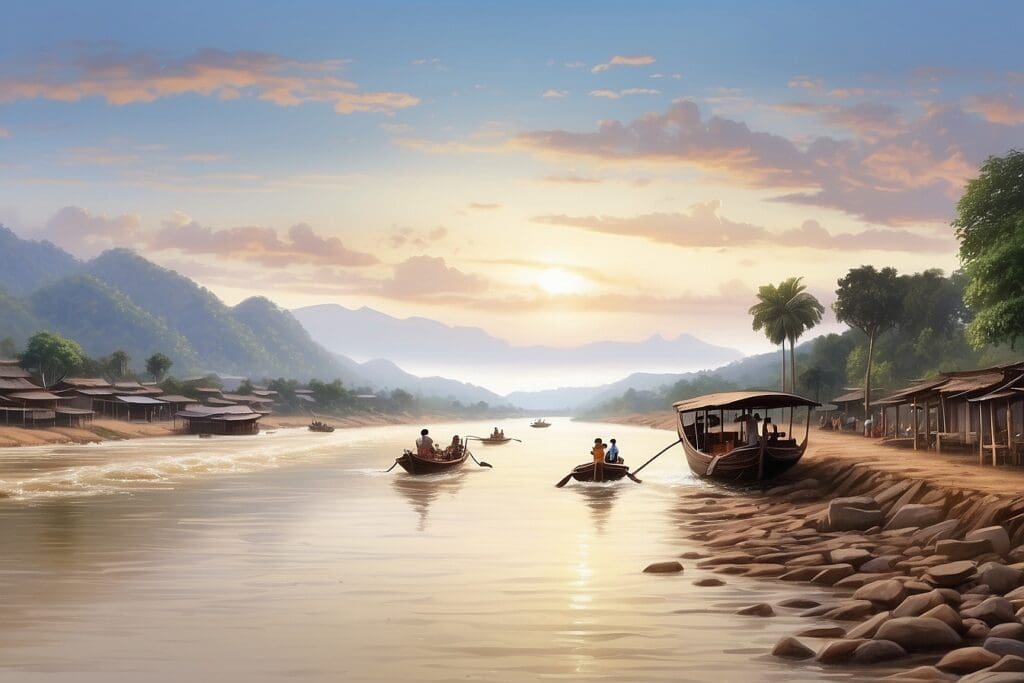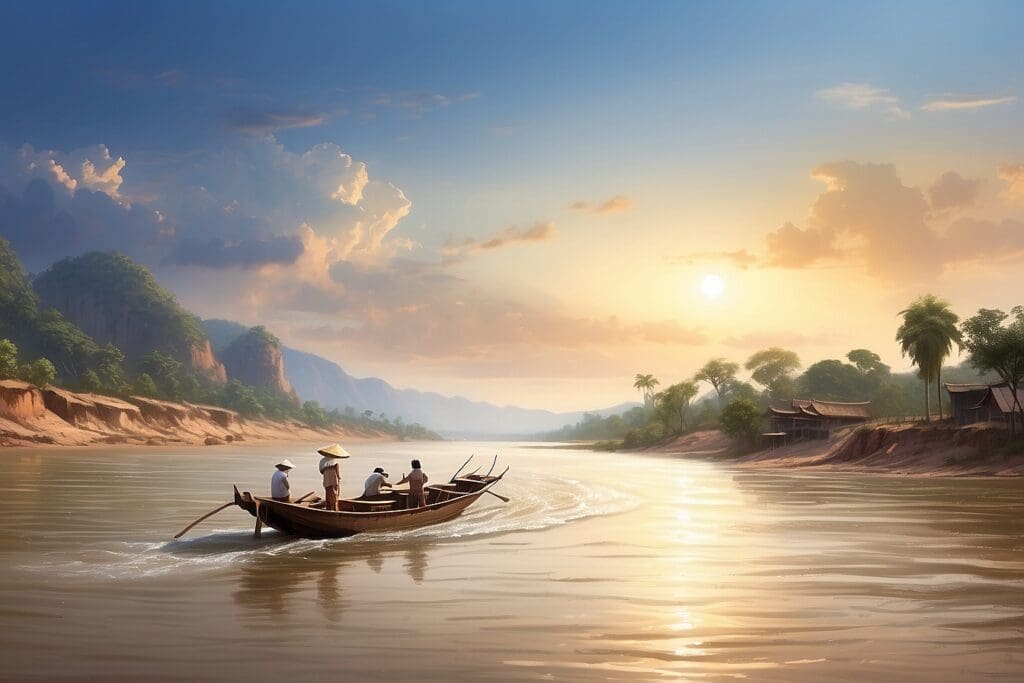Mekong River: Obstacles to protecting the Irrawaddy Dolphin…
I am sitting in a wooden long-tail boat with Thomas, a Lao man whose white teeth contrast with near-black skin as he creases his face into a smile. From beneath the shade of his billowing hat, Thomas (his adopted English name) tells me that he was born, and will also die, on Don Det, one of Laos’ Four Thousand Islands. The Four Thousand Islands, or Si Phan Don in Lao, sit in the middle of the Mekong River Delta. During the dry season, from November to April, the waters recede to reveal literally thousands of sandbars, hence the name. The Mekong River gives life to millions, originating in China’s Tibetan Plateau before flowing through Laos, Cambodia, Thailand, Myanmar (Burma), and Vietnam. The Mekong’s biodiversity is second only to that of the Amazon, and over 1200 species of fish have been identified in its waters. Of these 1200, some 120 are commercially traded.1 However, commercial fishing techniques and hydroelectric dams now jeopardize the well-being of many of the Mekong’s inhabitants, including the critically endangered Irrawaddy Dolphin (Orcaella brevirostris).
I am sitting in Thomas’ boat because I hope to glimpse one of these Irrawaddy Dolphins. First noted by the zoologist John Anderson in the 19th century in what was then Burma,2 there are an estimated 7000 living in discontinuous pockets in “coastal, shallow, brackish, or fresh turbid waters at the mouths of rivers in south-eastern Asia and Australasia.”3 The WWF classifies the 10% of Irrawaddy Dolphins found outside of Bangladesh as ‘critically endangered.’4 Scientists place the Irrawaddy “in the family delphinidade” and believe that “its closest relative might be the Killer Whale.” It averages “210 cm with a body mass of 115-130 kilograms” and lives for about 30 years. 5
As a child, Thomas, now 45, used to see the rounded nose and small dorsal fins of Irrawaddy Dolphins when they surfaced to breathe during his fishing trips. He still sees them today, though not nearly as often, and never by chance. Thomas runs Dolphin Tours, a boating operation which brings people like me to see the region’s last remaining dolphins. There are estimated to be less than 80 dolphins inhabiting a 190 kilometer stretch between Si Phan Don, Laos and Kratie, Cambodia.6 Thomas says that the dolphin’s decline began with the arrival of electric and dynamite fishing, both now illegal, and nylon cast nets and gill nets in the 1970s. Catching the dolphin was rarely intentional—many fishermen in Southeast Asia regard Orcaella ‘as sacred animals’7 —but it had often drowned by the time the fishermen were able to remove it from their nets. By the 1990s, several local committees and NGOs (Non-Governmental Organizations) had begun efforts to help the Irrawaddy Dolphin recover.
The Lao Community and Fisheries and Dolphin Protection Project began in 1993. It’s purpose is “supporting the […] government and rural villages living next to, or on islands in the middle of, the Mekong River to sustainably manage and conserve natural and aquatic resources in the district.”8 Understanding that preservation begins with early education, the LCFDO had students craft essays themed, “Managing Indigenous Fisheries for the Benefit of the Lao People.”9 It was a modest project for a modest community, a community whose people were happy with a good daily catch. The project proved effective: after reading his son’s essay criticizing the “use of explosives in fishing,”10 one “father of a student stopped trading fish from Cambodia that had been caught using explosives.”11 A joint effort between the United Nations Environment Program and the Center on the Conservation of Migratory and Wild Animals (UNEP-CMS) produced an Action Plan for the Conservation of Freshwater Populations of Irrawaddy Dolphins that established freshwater conservation zones and “programs to compensate fishers for damage caused to their nets.”12 The program also encourages fishermen to use traditional fishing methods.
Educating local fishermen about their bad habits has solved only part of the problem; dams built upstream of Si Phan Don further complicate matters.13 The waterfalls and rapids that prevented the Mekong from ever becoming a viable long-distance transport route are now providing energy for millions of people throughout the region. China is “operating three hydroelectric dams built across the Mekong River, and is planning to construct five more dams. At present, there are 11 hydro-electric dams believed to be under construction in Cambodia and Laos.”14 For more information on Dams in China, please see the Greeniacs Article on the Three Gorges Dam: http://www.wordpress-837916-4114959.cloudwaysapps.com/GreeniacsArticles/Three-Gorges-Dam.html.

In fact, there is a dam proposed not far from where our boat sits with its engine idling. The Don Sahong Dam, which is currently under consideration by the government of Laos, has been met with protest from both local and international environmental groups. According to a report from the World Fish Centre, the project “would block the crucial passageway through the Hou Sahong channel, the only major channel of fish migration between Cambodia and Laos, causing havoc to the normal breeding cycles and put at risk 70% of the fish catch in the Lower Mekong Basin.”15
The consequences of such a disruption extend beyond the Irrawaddy Dolphin—which would find many of its staple foods affected—to Laos’ economy. 78% of Laos’ total fish production, which is 64,600 tons,16 comes from wild capture fisheries. An improved road system has allowed fishermen in southern Laos to switch from subsistence fishing to commercial fishing, as they can send their catch to markets as far away as the capital city of Vientienne and across the border to Thailand. Risking 70% of the fish catch in Laos’ most productive region for cheaper energy is a risk that most, including my guide Thomas, are not willing to take.
Thomas tells me that there are legends about Irrawaddy Dolphins saving men from drowning. We plow the waters for another hour, seeing nothing, and I began to feel that the Irrawaddy Dolphin is just that: legend, myth, a tale spun to reveal the folly of mankind. We turn the boat around and begin a disheartened trip back to shore. Thomas spots the dolphin first and instinctively switches off the motor. There, in a river flooded with dam proposals, a lone Irrawaddy Dolphin surfaces to breathe, giving off a small, hopeful spout. Legend is not yet the case, and I hope will never be.





